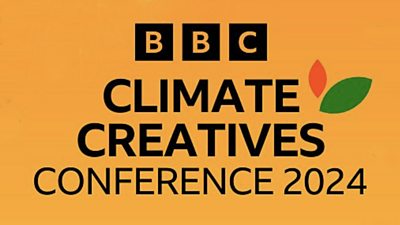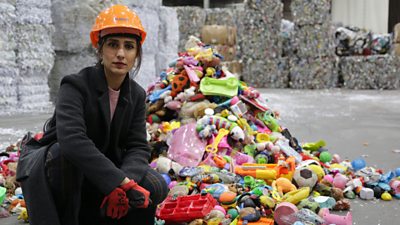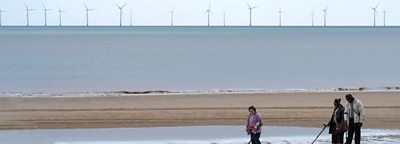shows that audiences are increasingly aware of the challenges facing the planet from climate change and the loss of nature and are concerned about their impacts. As programme makers it’s important we reflect this on-screen and see the creative opportunity to connect with audiences about a subject they really care about and which is relevant to their lives.
to reach more audiences with content that informs and inspires them on this topic. All the producers we work with must have a conversation with their commissioner about how they can reflect sustainability or the environment in the editorial of their programme, and at the end of production we ask them to track when and how these themes appear on-screen.
We're committed to:
- Growing our reach, bringing these topics to all audiences, not just those for whom programming branded as ‘environmental’ appeals.
- Increasing understanding of climate change and nature loss, including how we adapt and what solutions there are available. But this needn’t be a lecture!
- Portraying behaviour by seamlessly and authentically portraying sustainable behaviours in our content, effectively reflecting changes that are already afoot.
- Inspiring informed choices, growing people’s personal connection to nature and their ability to imagine a sustainable future.
Types of inclusion
We don't expect all our content to directly deal with climate change. In fact, a powerful way to engage with the topic is through content that takes sustainability into everyday experiences.
The inclusion of environmental themes and behaviours can be both explicit, where they are directly referenced, or implicit, where they are portrayed but not directly commented on.
Prominence on-screen can also vary. It can be the main focus or theme of the editorial such as in our natural history output like Springwatch/Autumnwatch or Planet Earth III, in consumer-focused approaches like What They Really Mean for You, Heat Pumps, and in dramas like Showtrial which hinged on an environmental activist’s murder. While The Repair Shop doesn’t explicitly reference sustainable themes the entire premise is to restore and value what you have.
Themes and behaviours can also be part of a sub-plot, secondary storyline or short item. Advertising electric motorbikes was a challenge on The Apprentice, The Hit List included a question about eco-friendly albums, and re-opening a coal mine was a sub-plot in Sherwood. Taking a more implicit approach, Money for Nothing explored how to make a profit from re-purposing wood off-cuts and Saturday Kitchen has featured vegetarian and vegan recipes. Neither programme foregrounded the environmental aspects and instead focussed on other benefits such as money and taste
Mentions in passing can be effective. This could be an off-hand reference such as DCI Silva saying she drives an electric vehicle in the second series of Vigil, or Escape to the Country pointing out solar panels on a property.
Across genres, sustainable themes can be featured visually such as shots with wind turbines in the background, characters or contributors cycling or using resuable drinks bottles/cups, or other visual representation of environmental infrastructure or behaviours.
Top storytelling tips
Whatever the genre there are some universal strategies for effective and authentic environmental content:
Action led storytelling: Rather than focusing on issue led stories, show ordinary people taking action in and with their communities.
Solutions: Balance the negative impacts of climate change and nature loss with solutions and their benefits – or even better, focus on improving lives now such as the immediate health advantages of clean air, with a healthier planet being an additional happy outcome.
Speak human and listen: If you are talking directly about environmental topics use everyday language. Combine passion and credibility with an understanding of where your audience is coming from.
Show the bigger picture: Hold governments and businesses to account. Speak to the audience as active citizens, employees, investors and role models in their communities, not just consumers.
Don’t forget nature: Feeling personally connected to nature is very effective at inspiring choices to support our planet. Reflecting, portraying and enhancing audiences’ sense that they are part of the natural world, not separate from it, could increase the impact of your content.
Embedding sustainable topics and themes on-screen
Changes to are the most impactful actions to reduce an individual’s carbon footprint in a country like the UK, while a personal connection with nature is one of the biggest motivators. Producers may therefore want to focus on these areas over actions like recycling when looking at ways to embed sustainable themes on-screen. However, it’s important to remember that personal choices also rely on broader changes such as the availability, cost and convenience of low-carbon options, and that these themes can be a point of narrative tension, not just consensus. The vast majority of people care about the environment, but not everybody is ‘signed up’ to the same actions.
Below are some areas you may want to consider that mirror how we track sustainable themes on-screen across our content, with examples of programmes that have embedded these themes in different ways and links to further information in our .
People witnessing or impacted by climate change or nature loss
This could be
- Changing landscapes, decline of species or relocation due to climate impacts.
- Extreme weather such as flooding, heatwaves, wildfires, droughts, intense storms, and its consequences eg cancelled events, travel disruption, food shortages/inflation or migration.
- Impacts of air pollution and climate change on physical health such as asthma, heatstroke and heat exhaustion.
- Mental health impacts of climate change such as climate anxiety, stress and grief for the loss of the natural world, trauma from extreme weather.
Examples
In unscripted, alongside our natural history output these topics feature in travelogues – including Simon Reeves’ series such as Wilderness with Simon Reeves and The Misadventures of Romesh, Madagascar. The One Show has featured items on air pollution outside primary schools and Escape to the Country has highlighted residents whose homes are at risk from coastal erosion in Norfolk.
In scripted, Casualty featured the impact of a storm and is set against a backdrop of sea level rise in Margate.
See to learn more about the science of climate change and , including extreme weather, for the health impacts of climate change, and for information about nature loss.
Adapting to climate change
This could be
- Flood defences, solar shading, drought resilient crops and managed retreat from vulnerable locations.
- Nature based solutions such as urban greening or creating floodplains and using mangroves to stabilise shorelines.
Examples
My Life featured a girl in rural Kenya adapting to challenges posed by climate change and Escape to the Country has featured beaver reintroduction as a solution to flooding.
See to learn about adapting to the impacts of climate change.
Travel: people and goods
This could be
- Sustainable ways to travel such as electric cars, trains or public transport.
- Active transport like cycling and walking.
- Innovations in this space such as low carbon shipping.
- Remember to avoid glamourising unsustainable choices around travel, such as private jets.
Examples
In unscripted, What They Really Mean for You, Electric Cars gave the low down on the electric vehicle revolution, Â鶹ԼÅÄ Sport made inserts about their train journey to cover the World Athletics Championships in Budapest, and the premise of Race Across the World is adventure travel without planes.
In scripted there are a myriad of ways to feature alternatives to petrol and diesel cars, from charging points in EastEnders to electric car related jokes in Mammoth.
See for more about sustainable transport and for the health benefits of sustainable transport.
Energy and its uses
This could be
- Renewables, energy infrastructure such as solar panels, wind turbines and grid upgrades.
- Energy efficiency such as insulation, turning the heat down and wearing jumpers and switching off appliances.
- Alternatives to gas boilers such as heat pumps.
Examples
In unscripted, green builds have featured in DIY SOS and eco-villages in Escape to the Country. News and topical programmes across the UK’s major broadcasters, including The One Show and Morning Live, focused on energy saving tips at the peak of the cost of living crisis to save cash and implicitly help the planet. In the first week one tip alone – on turning down the thermostat by one degree – meant that broadcasters helped over four million people save energy, thereby saving an estimated one million tonnes of carbon .
In scripted, Sherwood series two featured shots of wind turbines in the landscape while Vigil series two referenced the vulnerability of being reliant on oil-states.
See to learn more about energy generation, for buildings, and for industry.
Food
This could be
- Sustainable choices for food, or being offered, debating or discussing more plant-based options.
- Ways to reduce food waste such as utilising imperfect fruit and veg, meal planning and using/freezing leftovers.
- Composting.
Examples
In unscripted, plant-based rounds have featured in The Great British Menu, while Morning Live has done a focus on reducing food waste.
In scripted, hapless heroine Mandy is a vegetarian while in I May Destroy You Arabella takes a job at a vegan delivery startup, and it’s easy to show characters recycling their food waste or cooking plant based meals.
See to learn more about this subject and on the co-benefits of reducing emissions from food.
Using land sustainably and restoring nature
This could be
- Nature friendly farming.
- Nature restoration, planting for nature, rewilding.
Examples
Countryfile has looked at regenerative farming but this was also explored in Marcus Wareing Simply Provence. Eco-friendly gardens have featured in Your Garden Made Perfect and EastEnders’ Albert Square acquired a pair of planted up pink boots as part of Radio 2’s Let it Grow.
See for more on land use, and for more about nature loss and how to combat it.
Clothes, purchases and reducing waste
This could be
- Buying or selling fewer and more sustainable products and clothes, including opting for second-hand or sharing locally.
- Recycling, upcyling or repairing and reusing broken items or clothes.
- Reusable shopping bags, water bottles and travel mugs and avoiding single use items.
- Background advertising with sustainable themes such as generic ‘green’ products.
- Remember to think carefully about glamourising unsustainable and high carbon lifestyles.
Examples
Antiques Roadshow, The Repair Shop and Sort Your Life Out all have an underlying theme of re-use behind them. Reduce, Reuse and Recycle week is a fixture in The Great British Sewing Bee and Style It Out saw kids compete by creating outfits from preloved and rescued clothes and materials.
See for more on the impact of individual behaviour change and on unsustainable lifestyles.
Work, business and money
This could be
- Jobs, businesses or work scenarios that will be affected by the transition to Net Zero eg oil and gas workers, farmers, boiler fitters.
- Jobs, businesses or work scenarios related to environmental sustainability.
- Sustainable investments and pensions and how to pay for the transition to a more sustainable world.
- Alternative economic systems such as doughnut economics, a circular encomony, and degrowth.
Examples
Dragon’s Den's Deborah Meaden grills would-be entrepreneurs on the green credentials of their business ideas and EastEnders has featured characters having a conversation about doughnut economics.
See for information on the economic impacts and opportunities of the transition to Net Zero and for more about green finance.
Communities and creativity
This could be
- Sharing, discussing or debating the topics with friends, communities and colleagues.
- Community action, protests, activism.
- Songs, art, novels or other creative works engaging with the topics.
- Involvement of local groups with local or national politicians on the subject.
Examples
Communities engaging with climate and nature has been a great way in for The One Show, which ran a Growing Together Award celebrating community gardening. Blue Peter has tapped into young people’s imagination and creativity with competitions focused on finding solutions for environmental problems.
See for more on the impact of individual behaviour change.
People's relationship with and access to nature
This could be
- Noticing and appreciating nature and the natural world – from window boxes to the great outdoors – through all our five physical senses.
- Recognising nature’s beauty, the emotions it inspires in us, and how it can bring meaning and structure to our lives, such as through the passing of seasons.
- Caring for and taking action for nature, such as planting and restoring nature.
- Access to green spaces.
Examples
Sunday Morning Live has run items on tending church grounds for nature. Pilgrimage, The Road Through North Wales featured Michaela Strachan’s close relationship with nature. Our relationship with nature is a key theme of the Â鶹ԼÅÄ film Harvest.
See for more on what individuals can to do support nature.
Industries and behaviours that cause climate change or nature loss
This could be
- Fossil fuel extraction and use such as in energy generation, heating, transport and industry.
- Deforestation and other changes to land use.
- Unsustainable diets or farming practices or general over-consumption of goods and products.
Examples
In unscripted On Thin Ice: Putin v Greenpeace explored Russia’s determination to drill for oil in the Arctic and in scripted the bid to reopen a coal mine was a subplot in Sherwood series two.
See for more on the causes of climate change, and for the key causes of nature loss.
Audience research and resources
Find out more about how audiences view sustainability and climate change.
Â鶹ԼÅÄ Audiences sustainability research
Our latest Â鶹ԼÅÄ Audiences sustainability tracker research suggests that the environment continues to be an important topic to the UK public, with recent tracking suggesting that 53% of people claim it’s of high importance to them and just 8% ranking it of low importance.
Â鶹ԼÅÄ Engaging audiences with sustainability guide
Find out more about how audiences view sustainability and climate themes as well as how they can be reflected onscreen in our guide.
-
PDF
-
 Climate change science and solutions
Climate change science and solutions -

Climate Creatives Conference
Watch recordings of the Â鶹ԼÅÄ event -
 Case studies and guidance from albert
Case studies and guidance from albert
Please note the Â鶹ԼÅÄ is not responsible for the content of external websites.
Explore the site
-
Briefs and contacts
Commissioners and ideas -
Supporting indies
How we commission and work -
Skills and training
Industry training and skills development
